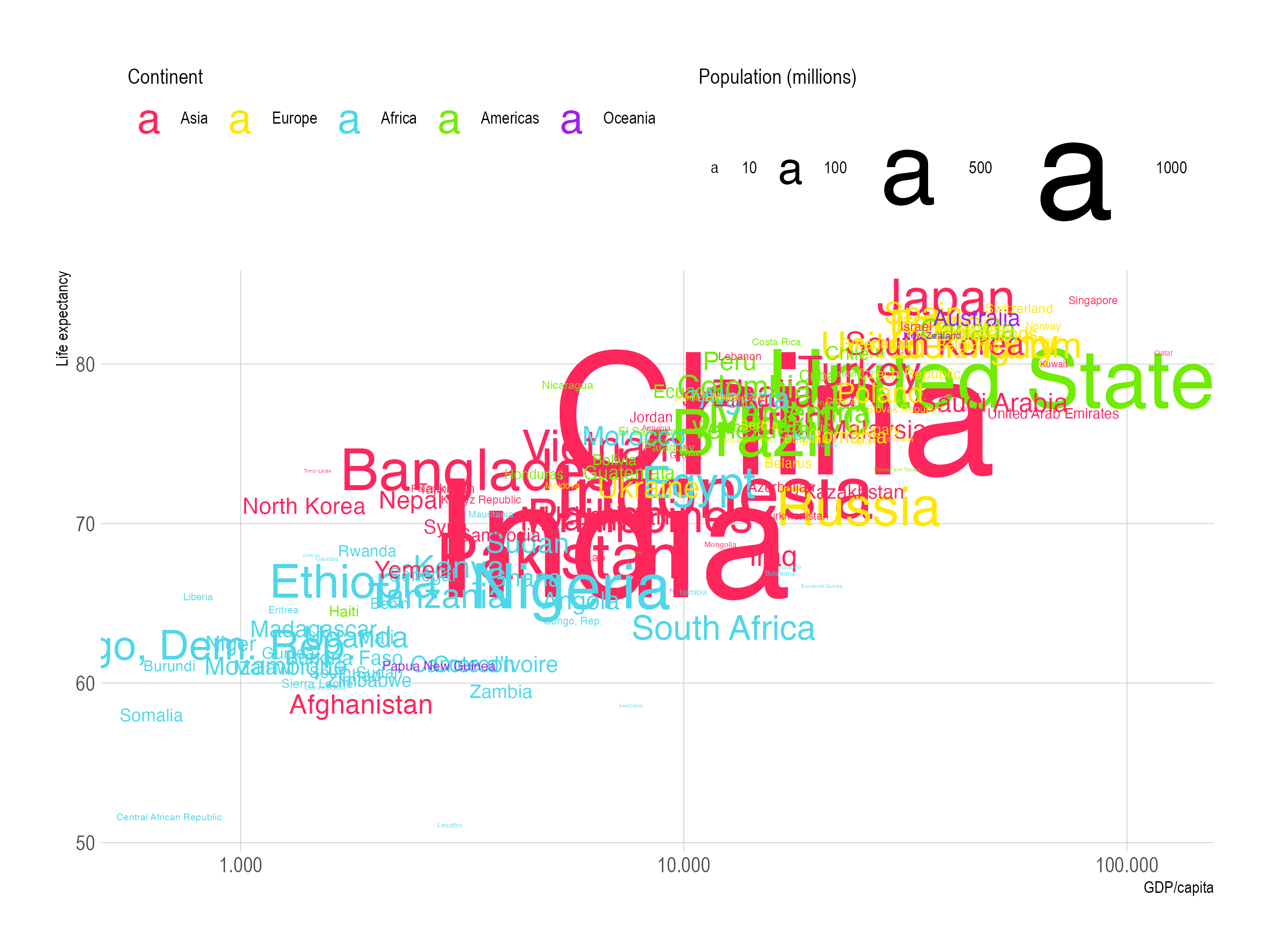Many geometries share the same aesthetics, but some geometries have aesthetics specific to them. The different implementations of the Grammar of Graphics also differ a little bit in their implemented aesthetics.
0-dimensional geometries
Point geometries
The common aesthetics for point geometries over all 3 implementations are:
xyshapesizefillstrokeopacity
Observable Plot and Vega-Lite offer some additional aesthetics for point geometries:
stroke widthfill opacitystroke opacityrotationstroke dash pattern
Text geometries
Text geometries share some aesthetics with point geometries. Those are the following:xyfillopacityrotation
But text geometries also have some very specific aesthetics. Most importantly, the text content aesthetic needs to mapped from the data. In the following plot the country variable is mapped text content of the text geometry. Like in the previous variations of this plot, population is mapped to the size aesthetic and the continent is mapped to the fill colour aesthetic.

Source: Maarten Lambrechts, CC-BY-SA 4.0
Other than the text content, the text specific aesthetics are:
- font
size font family: for example “Arial”, “Times New Roman”, …font weight: for example “normal” or “bold”horizontal text alignment: the horizontal alignment of the the text relative to the x and y position of the textvertical text alignment

Source: Maarten Lambrechts, CC-BY-SA 4.0
The same plot as above, but with the population variable mapped to the rotation aesthetic of the text geometry. As you can see, not all aesthetic mappings are effective or make sense. Source: Maarten Lambrechts, CC BY SA 4.0
1-dimensional geometries
1-dimensional geometries are straight lines, curved lines or lines following a path connecting multiple data points. Different kinds of 1-dimensional lines require different aesthetics to be generated, see 1-dimensional geometries for an overview of the required aesthetics for the different kinds of line geometries.
Apart from the required position aesthetics, line geometries can also have the following aesthetics:
stroke colour: the colour of the linestroke width: the width of the lineopacitystroke dash pattern: a line can be solid (no dash pattern), or can have a specific dash pattern

A line chart using the stroke dash pattern aesthetic. Source: vega.github.io/vega-lite/examples/line_strokedash.html
Remember that for multi-series line charts, an aesthetic needs to be provided that groups the values in each series together. This can be done implicitly, for example by mapping the grouping variable to the stroke colour aesthetic, or explicitly by using the group aesthetic. The aesthetic for grouping observations together has different names in the different implementations. It is called
groupin ggplot2detailin Vega-Litezin Observable Plot
2-dimensional geometries
Apart from the aesthetics required to shape and position 2-dimensional geometries (see 2-dimensional geometries), the other aesthetics of these geometries are very similar to the ones of point geometries. This makes sense since 0-dimensional geometries use 2-dimensional objects, like circles, to represent dimensionless points.
So 2-dimensional geometries (rectangles and areas) share the following aesthetics with 0-dimensional ones:
fillcolourstrokecolouropacitystroke dash patternstroke widthfill opacitystroke opacity
The last 2 aesthetics are not supported by ggplot2.